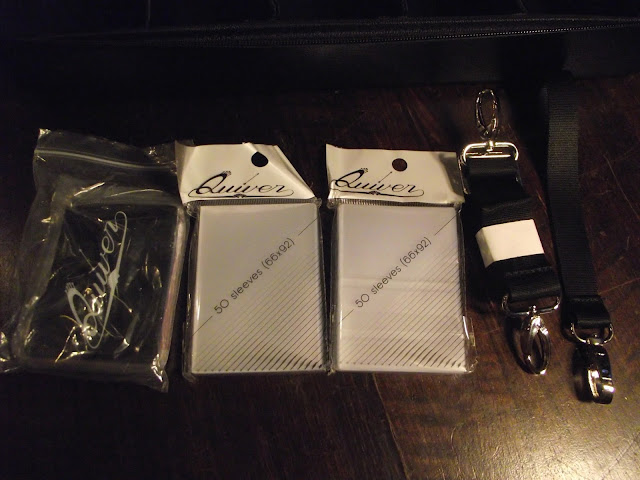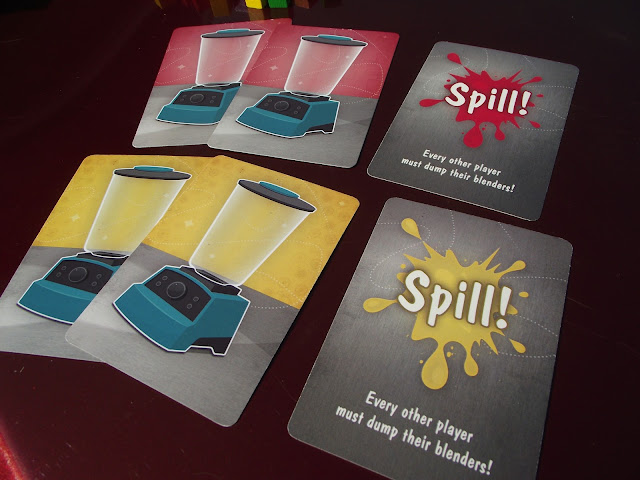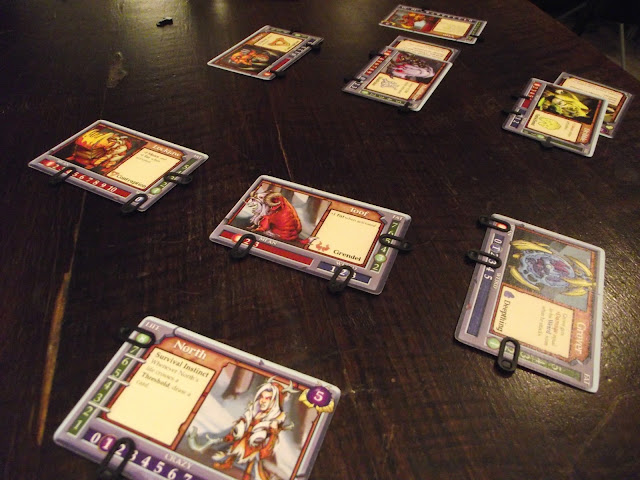Last year a new, tactical card game burst on the Kickstarter scene. With awesome artwork featuring an odd set of bizarrely mutated goats and an equally quirky collection of shepherds, Gruff was a huge success. Now, about a year later, Studio Woe is back with the first Gruff expansion, which also plays as a stand alone two player game. Clash of the Battle Goats is fully compatible with Gruff and adds two new shepherds and six new gruffs (mutant goats) to the mix (and more with stretch goals already being hit). I don't have Gruff, however, so this review is strictly about Clash as a stand alone game.
In Clash of the Battle Goats two players each take on the role of a shepherd with a small flock of thee mutant goats called gruffs. Mix and match shepherds and gruffs between Clash (which will come with at least six shepherds and six gruffs) and Gruff (with seven shepherds and fifteen gruffs) and then head out to do battle. Each shepherd has a unique ability and each gruff has a set of 15 ability cards with a variety of cool effects.
After selecting a shepherd and three gruffs, each player will then choose 8 of the 15 ability cards for each gruff to use in the game. This allows each player to construct a unique deck that caters to their intended strategy. The depth of this deck construction isn't anywhere near Magic the Gathering levels, but it allows a level of customization that is quick, yet meaningful. Alternatively you can play with eight random cards for each gruff, but that does pose the risk of getting unbalanced decks.
 |
| Track stats with special clips on the cards. They can occasionally be fiddly, but overall work OK. |
On your turn the first thing you do is resolve any battles they declared on your previous turn. That sounds odd, but it's one of the main mechanics that set Clash and Gruff apart from other tactical combat games. When you declare an attack your opponent has their entire turn to adjust their defensive strategy. This requires a drastic change to how you strategize for combat. You'll end up having to plan several turns in advance to make sure you have the right gruff in the right position and that your opponent won't be able to defend.
After resolving any attack from a previous turn the main part of your turn begins. First draw an ability card. Then choose a gruff to activate (turn it sideways to show it has been activated). Some gruffs have abilities that trigger when they are activated (like increase their Fat, Mean, or Weird stat, or sometimes something else). If the gruff has any Weird, your shepherd increases its Crazy level by the amount of Weird the gruff has. These are the only resources in the game, Weird and Crazy. In order to play ability cards your shepherd must be crazy enough. So activating weird gruffs allows your shepherd to play crazier ability cards.
 |
| The crazier your shepherd is the more powerful ability cards you can play. |
After a gruff has been activated, any activation abilities are triggered, and your shepherd gains any available Crazy, you may play any number of ability cards from your hand. The catch is the total amount of Crazy that the abilities cost can't exceed the total amount of Crazy your shepherd has. So if your shepherd has eight Crazy you can play a single card that costs eight, two cards that cost four, or any combination of cards as long as the total Crazy does not exceed eight. Your shepherd doesn't lose the Crazy, but it must be Crazy enough to play the cards.
There are three types of ability cards, Actions, Conditions, and Mutations. Actions are resolved immediately. They can do things like increasing a gruff's stats, moving a gruff, removing Conditions and Mutations, and more. Conditions are active for an entire round (i.e. until the beginning of the active player's next turn, after combat). These are usually cards that provide benefits (or penalties) to a gruff as long as they are active and certain conditions are met. They'll usually provide combat benefits in certain situations, although they can do other things, too. Mutations are generally permanent effects. They can be positive (so you'll place them on your gruffs) or negative (you'll place them on opponent gruffs) and sometimes are global mutations that affect all gruffs on on team. They'll generally stick around, but there are some abilities that allow you to discard mutations.
 |
| Different ability cards provide different benefits. |
After cards are played comes the critical decision. What to do with your activated gruff. You have four choices. You can either Grow, which means you increase any single stat for your gruff, Shift, which means you swap places with an adjacent gruff, Resurrect, which allows you to revive a gruff that has been defeated in combat, or Attack. Attacking is obviously what this game is really all about, but attacking is a lot more thoughtful in Clash than it is in most games. As I mentioned above, you don't resolve your attack right away. Instead, you simply declare your attack and move your gruff into position. Then you wait to see how your opponent is going to react on their turn.
 |
| Toof has six Fat, two Conditions, and one Mutation that make him a pretty solid defensive wall. |
You won't be able to activate your gruff again until after you've activated every other gruff on your team, so you must pay careful attention to which gruffs you activate when. There are some cards and situations that can change this, but generally you'll only get to use a gruff's abilities once every three turns. This is something to be aware of not only when activating your own gruffs, but when deciding what to do with them since which gruffs your opponent will be able to activate may be critical to your strategy. Sometimes it takes a couple of turns to make sure you have all your gruffs in just the right position to spring your trap for the big attack.
 |
| Lockjaw goes in for the attack! |
The mechanics of an attack are pretty simple. You compare the attacker's total Mean (attack strength) and any modifiers from Mutations or Conditions to the defender's total Fat (defense) and any modifiers. If the total attack damage meets or exceeds the total defense the gruff is defeated. This means the gruff gets flipped over and can't be used any more during the game until the owner uses a Resurrect action to bring the gruff back into play. Any excess damage passes through to the shepherd. If the total attack damage doesn't equal or exceed the defense nothing happens and the attack is over. There are no counter attacks, no reacts, nothing like that. But remember, the opponent has an entire turn to mount a defense, whether that means increasing the defending gruff's stats enough to fully block the attack, adding defensive Conditions and Mutations to the defending gruff, adding crippling Mutations or Conditions to the attacking gruff, moving a stronger gruff in to defend, or choosing which gruff to sacrifice to protect the shepherd as much as possible.
 |
| Lockjaw has a whole bunch of mutations from the opponent, but is it enough to stop his meanness? |
Turns continue until one shepherd's Life is reduced to 0. Then it's time to reset and battle again!
Final Thoughts:
When Gruff came out last year it won a number of awards. The innovative twist on tactical battle card games is definitely worthy of attention. The mechanics behind Gruff and Clash are simple: draw a card, activate a gruff, play cards, and take an action, but the delayed resolution of attacks, combined with the wide combination of characters and abilities, along with the simple deck construction choices make the battles in the Gruff universe unusually deep and tactical. Allowing your opponent an entire turn to mount a defense requires a completely new way of considering strategy. No longer are battles simply about getting the strongest attackers out at the right time. Now you have to coordinate to get them ready at a time when your opponent won't be able to respond. Sometimes this means going on the offensive right away with a series of small attacks. Other times it means biding your time until you can go for a big attack. Despite the simplicity there are a lot of bits of information to take into account. And, although most of the information about each player is public (aside from the ability cards in their hands), with a lot of moving parts even the best laid plans can sometimes be foiled.
 |
| Vim is the other shepherd that is standard in the game, but a bunch more will be coming with the Kickstarter stretch goals. |
As for how Clash holds up on its own though, the game I played felt a bit lacking in variety. With only two shepherds and six gruffs to choose from there didn't seem to be a whole lot of spice. The games I played all felt very different, despite playing with the same combinations most of the time, though. Depending on who I played against the games were fast, vicious battles, or longer games of push & pull while we maneuvered into position for the killing blow. Games lasted anywhere from 15 to almost 60 minutes. So, even with a limited variety of characters, the prototype of Clash of the Battle Goats does provide a breadth of interesting game play experiences.
 |
| The artwork is fantastically bizarre. Each goat is a treasure! |
However, the Kickstarter version of Clash is already being packed with four additional shepherds. This will add tremendously to the scope of Clash, making it feel more fleshed out as a stand alone game experience and less like an expansion that can also be played on its own. I'm not sure if there will be any new gruffs in the stretch goals for Clash, but if you pair Clash with Gruff you'll have an incredible amount of variety to choose from. Billions of different combinations, not including the Legendary Gruff cards that are included with Clash's stretch goals and the ability to refine each gruff's ability deck. I'm sure there will be future expansions as well, which will only add to the richness of the Gruff universe.






 , liking GJJ Games on Facebook
, liking GJJ Games on Facebook  , or following on Twitter
, or following on Twitter  . And be sure to check out my games on Tabletop Generation.
. And be sure to check out my games on Tabletop Generation. , liking GJJ Games on Facebook
, liking GJJ Games on Facebook  , or following on Twitter
, or following on Twitter  . And be sure to check out my games on Tabletop Generation.
. And be sure to check out my games on Tabletop Generation.




























































